DIY monitor backlight
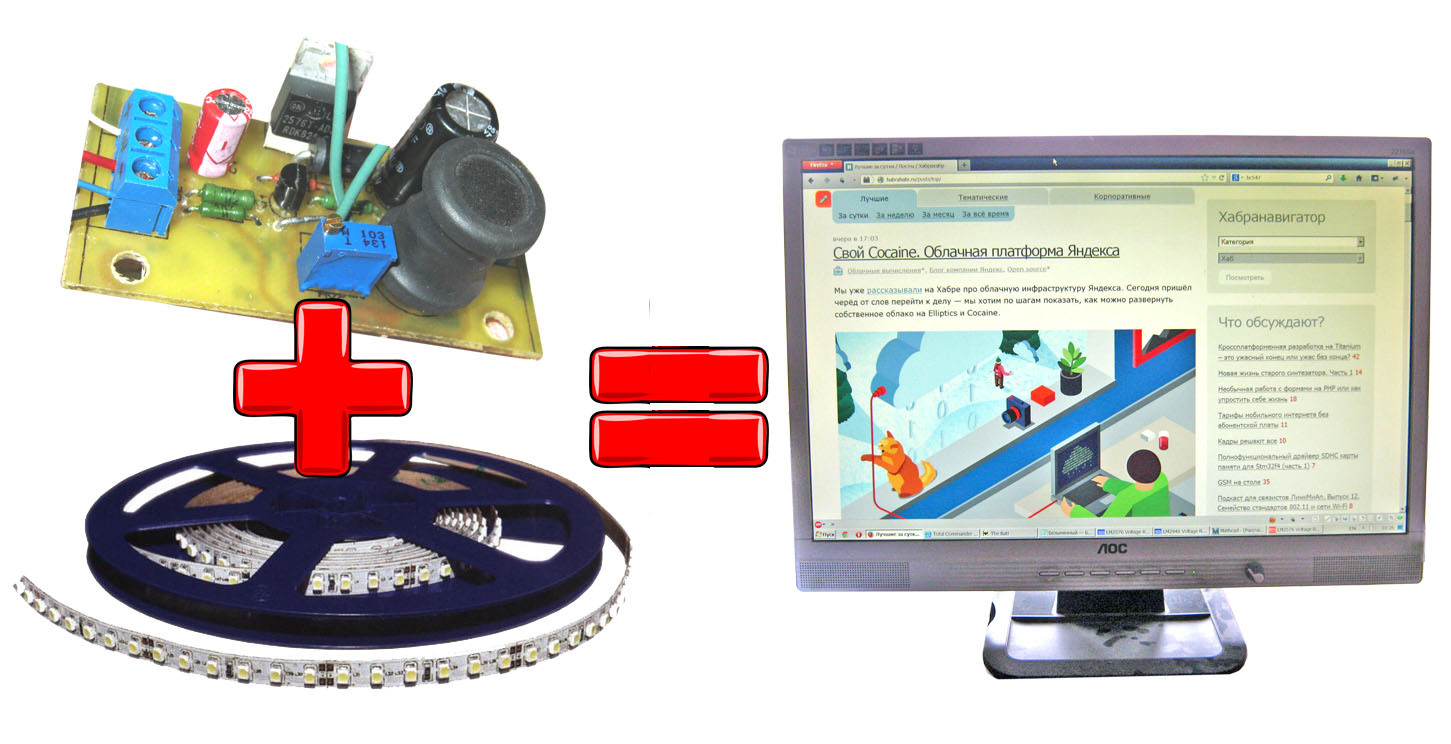
Time passes unnoticed and it would seem recently purchased equipment is already out of order. So, after working my 10,000 hours, they ordered the lamps of my monitor (AOC 2216Sa) to live for a long time. At first, the backlight did not turn on the first time (after turning on the monitor, the backlight turned off after a few seconds), which was decided by turning the monitor on / off again, over time the monitor had to be turned on / off already 3 times, then 5, then 10, and at some point it I could not turn on the backlight, regardless of the number of attempts to turn it on. The lamps of God, which were brought into the light, turned out to be blackened edges and legally set off for scrap. An attempt to replace the lamps (new lamps of a suitable size were purchased) was unsuccessful (the monitor was able to turn on the backlight several times,
Disassemble the monitor
A lot of articles have already been written on the topic of disassembling the monitor, all monitors are very similar to each other, so in short:
1. Unscrew the monitor supply mount and the only bolt at the bottom that holds the back wall of the case
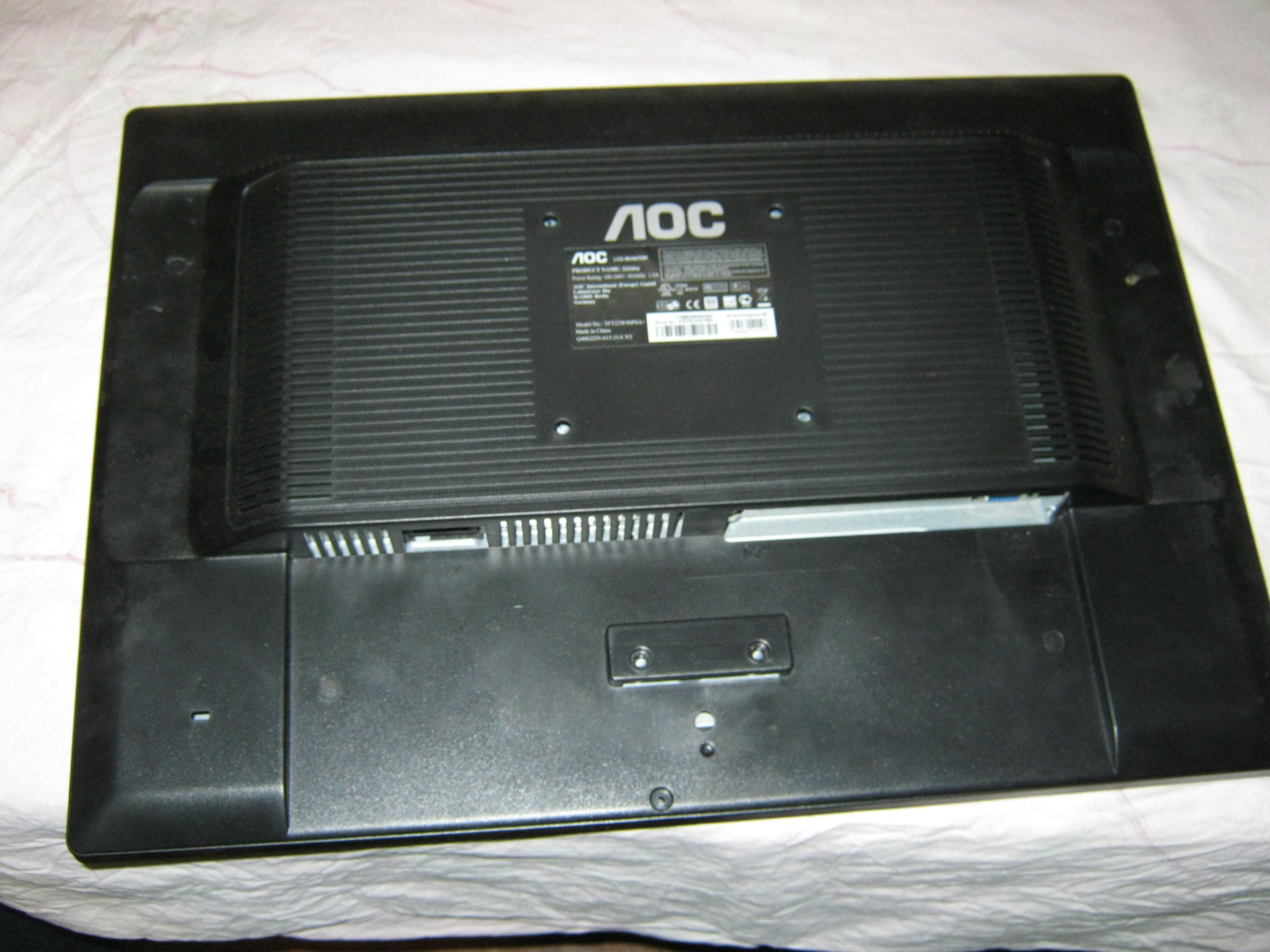
2. At the bottom of the case there are two grooves between the front and back of the case, into one of which we insert a flat screwdriver and begin to remove the cover from the latches around the entire perimeter of the monitor (simply by turning the screwdriver gently around its axis and lifting the case cover). You don’t need to make excessive efforts, but the case is only removed for the first time from the latches (for the time of repair, I opened it many times, so the latches began to be removed much easier over time).
3. We have a view of the installation of the inner metal frame in the front of the case:

We take out the board with the buttons from the latches, take out (in my case) the speaker connector and bend the two latches below, take out the inner metal case.
4. On the left are visible 4 wires connecting the backlight. We take them out slightly squeezing, because To prevent loss, the connector is made in the form of a small clothespin. We also take out a wide cable going to the matrix (at the top of the monitor), squeezing its connector on the sides (because the connector has side latches, although this is not obvious at first glance at the connector):
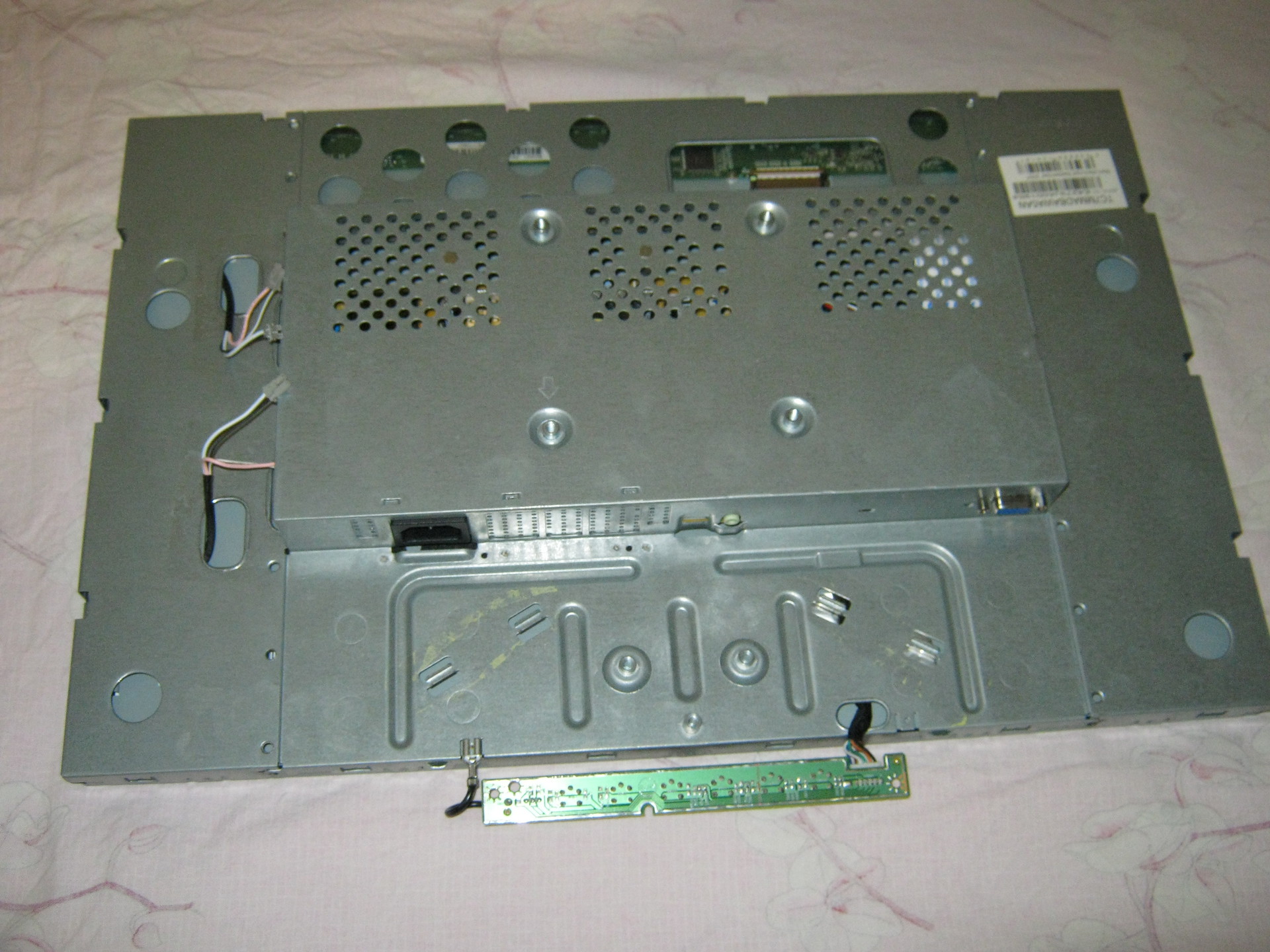
5. Now you need to disassemble the “sandwich” containing matrix and backlight:

Along the perimeter there are latches, which are opened by slightly prying the same flat screwdriver. First, the metal frame holding the matrix is removed, after which it is possible to unscrew three small bolts (an ordinary Phillips screwdriver will not work because of their miniature size, you will need a very small one) holding the matrix control board and the matrix can be removed (it is best to put the monitor on a hard surface, for example, a table covered with with the fabric matrix down, unscrewing the control board, putting it on the table, deploying it through the end of the monitor and just lifting the backlit case by lifting it vertically up, and the matrix will remain . Amb desk It is possible to cover something to not gathering dust and collect exactly in reverse - that is lying on the table to cover the matrix assembled body with light,
It turns out the matrix separately:

And the backlit unit separately:
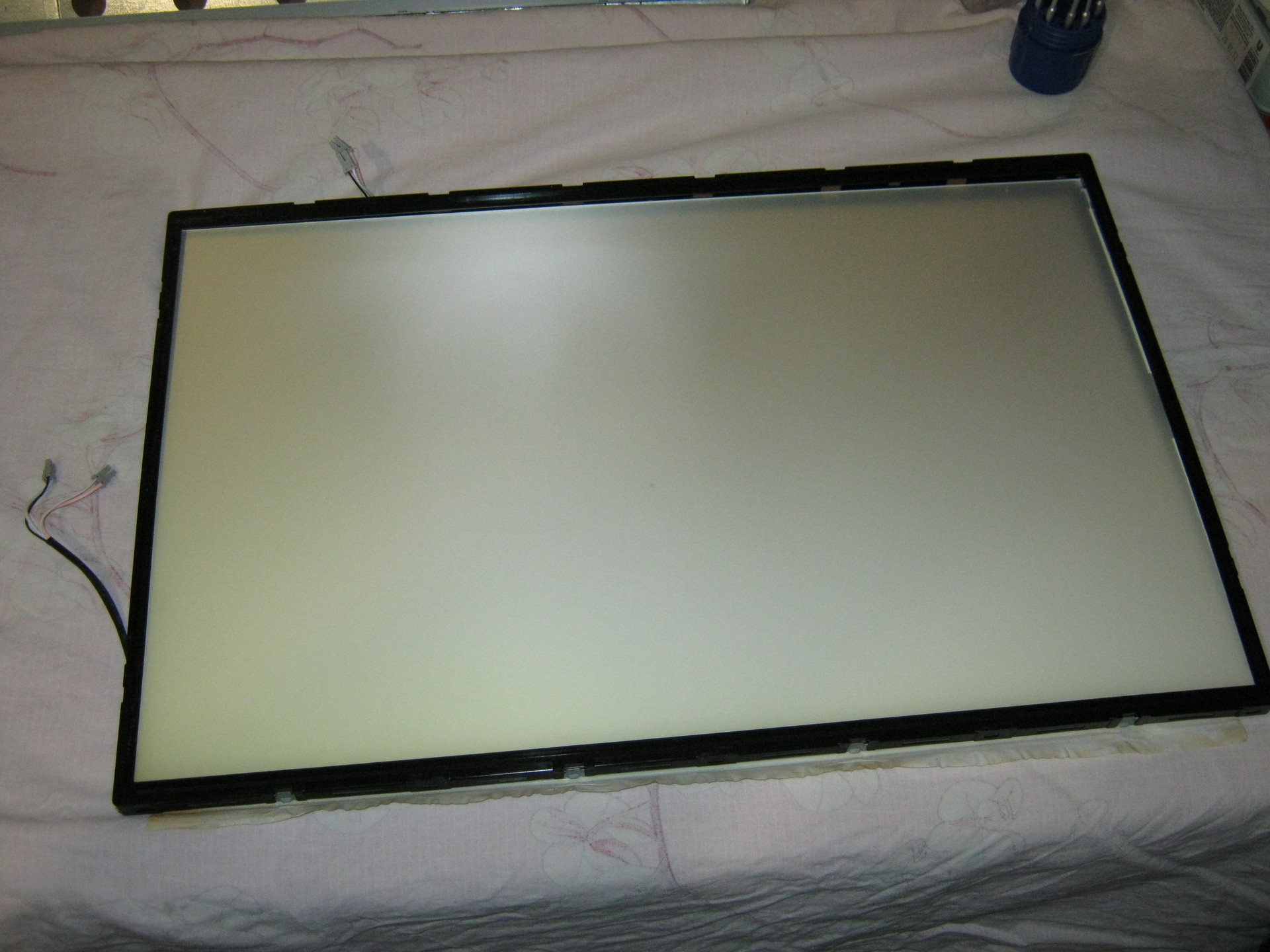
The backlit unit is disassembled similarly, only instead of the metal frame, the backlight is held by a plastic frame, which simultaneously positions the plexiglass used to diffuse the backlight. Most of the latches are located on the sides and are similar to those that held the metal frame of the matrix (they can be opened by tucking with a flat screwdriver), but there are several latches on the sides that open “inward” (you need to press on them with a screwdriver so that the latches go inside the case).
At first, I remembered the position of all the parts to be removed, but then it turned out that they could not be assembled “wrong” and even if the parts looked absolutely symmetrical the distances between the latches on different sides of the metal frame and the locking tabs on the sides of the plastic frame holding the backlight would not allow them to be assembled “incorrectly” ".
That's all - we disassembled the monitor.
LED backlight
At first it was decided to make the backlight of the LED strip with white LEDs 3528 - 120 LEDs per meter. The first thing that turned out to be was the width of the tape was 9 mm, and the width of the backlight (and the seat for the tape) was 7 mm (in fact, there are two standard backlight lamps - 9 mm and 7 mm, but in my case it was 7 mm). Therefore, after inspecting the tape, it was decided to cut 1 mm from each edge of the tape, because this did not hurt the conductive paths on the front of the tape (and on the back along the entire tape there are two wide supply cores, which will not lose their properties by a decrease of 1 mm on the backlight length, because the current will be small). No sooner said than done:

Likewise, the LED strip is neatly trimmed along its entire length (the photo shows an example of what happened before and what happened after trimming).
We need two strips of tape at 475 mm each (19 segments of 3 LEDs per strip).
I wanted the monitor backlight to work the same as the regular one (that is, turn it on and off by the monitor controller), but I wanted to adjust the brightness “manually”, as on old CRT monitors, because this is a often used function and I’m tired of climbing the on-screen menu every time (in my monitor, the right and left keys control not the monitor modes, but the volume of the built-in speakers, so each time I had to change the modes through the menu). For this, a manual was found on the network for my monitor (for those who need it, it’s attached at the end of the article) and on the page with the Power Board, + 12V, On, Dim and GND were found that interest us.

On - signal from the control board to turn on the backlight (+ 5V)
Dim - PWM control of backlight brightness
+ 12V turned out to be far from 12, but somewhere 16V without load, backlight and somewhere 13.67V with load.
It was also decided not to do any PWM settings for backlight brightness, but to power the backlight with direct current (at the same time it is decided the question is that on some PWM monitors, the backlight works at a not very high frequency and some have a slightly more tired eyes). In my monitor, the frequency of the native PWM was 240 Hz.
Further on the board, the contacts were found to which the On signal is sent (marked in red) and + 12V to the inverter unit (the jumper that must be removed to de-energize the inverter block is marked in green). (photo can be enlarged to see notes):

The LM2941 linear regulator was taken as the basis of the control circuit mainly for the fact that at currents up to 1A it had a separate On / Off control terminal, which was supposed to be used to control the on / off illumination of the On signal from the monitor control board. True, in LM2941 this signal is inverted (i.e. there is voltage at the output when the On / Off input has zero potential), so I had to assemble an inverter on one transistor to match the direct On signal from the control board and the inverted input of LM2941. The circuit does not contain any other excesses: The

calculation of the output voltage for LM2941 is performed according to the formula:
Vout = Vref * (R1+R2)/R1where Vref = 1.275V, R1 in the formula corresponds to R1 in the circuit, and R2 in the formula corresponds to a pair of resistors RV1 + RV2 in the circuit (two resistors are introduced to more smoothly adjust the brightness and reduce the range of voltages regulated by the variable resistor RV1).
As R1, I took 1kOhm, and the selection of R2 is carried out according to the formula:
R2=R1*(Vout/Vref-1)The maximum voltage we need for the tape is 13V (I took a couple more than the nominal 12V so as not to lose in brightness, and the tape will survive such an easy overvoltage). Those. the maximum value of R2 = 1000 * (13 / 1.275-1) = 9.91kOhm. The minimum voltage at which the tape still glows somehow is about 7 volts, i.e. minimum value R2 = 1000 * (7 / 1.275-1) = 4.49kOhm. R2 we have consists of a variable resistor RV1 and a multi-turn trimming resistor RV2. The resistance of RV1 is 9.91kOhm - 4.49kOhm = 5.42kOhm (we select the closest RV1 value is 5.1kOhm), and we set RV2 to about 9.91-5.1 = 4.81kOhm (in fact, it is best to first assemble the circuit, set the maximum resistance RV1 and measure the voltage by the output of LM2941, set the resistance RV2 so that the output has the desired maximum voltage (in our case, about 13V).
LED Strip Mounting
Since after the cutting of the tape by 1 mm at the ends of the tape the power cores were exposed, I glued the electrical tape on the body in the place where the tape will be glued (unfortunately not blue but black). A tape is glued on top (it is good to warm the surface with a hairdryer, since adhesive tape is much better glued to a warm surface):
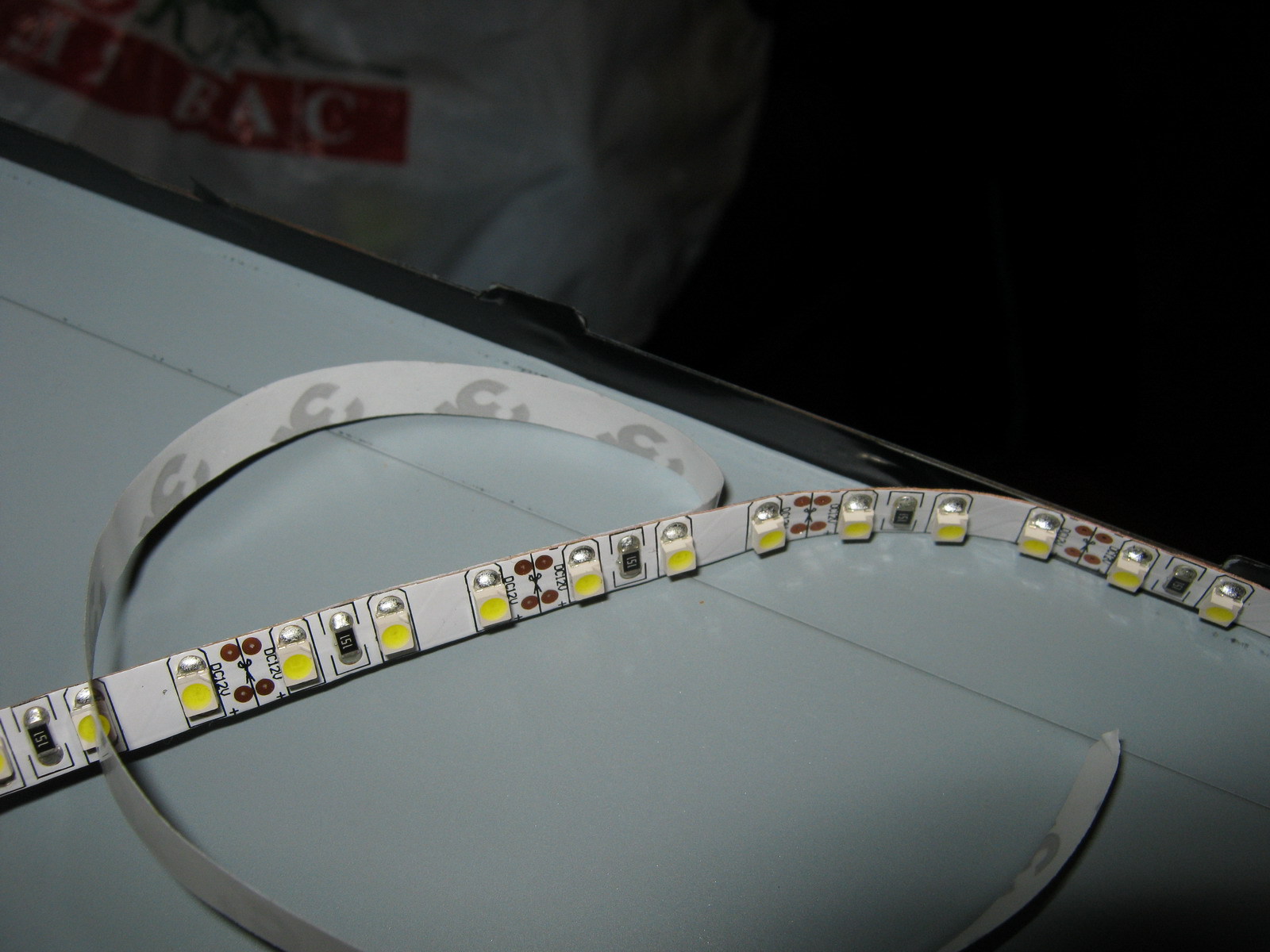
Then the back film, plexiglass and filters that lay on top of the plexiglass are mounted. At the edges, I supported the tape with pieces of eraser (so that the edges on the adhesive tape did not go away):
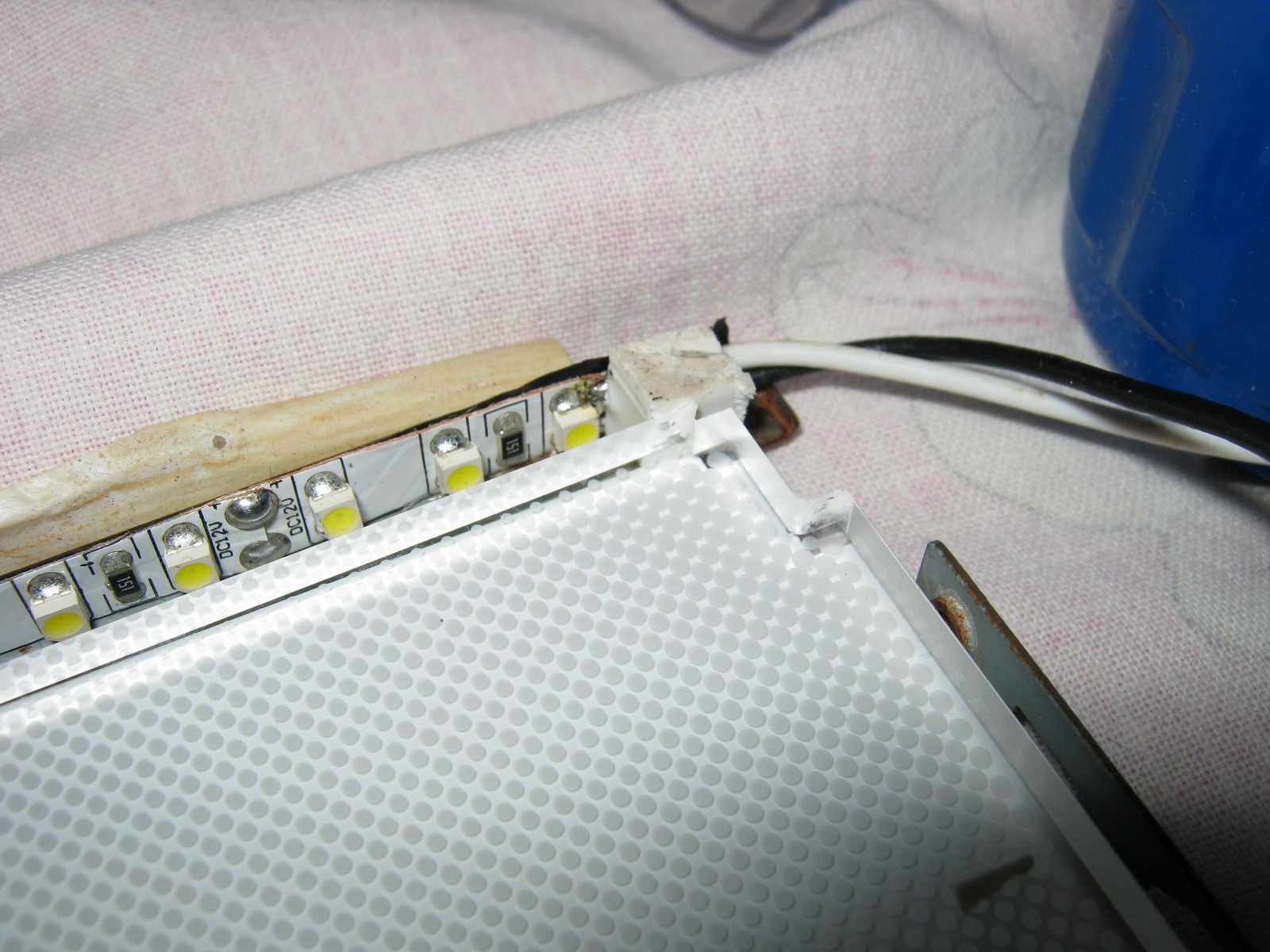
After that, the backlight unit is assembled in the reverse order, the matrix is replaced, the backlight wires are brought out.
The circuit was assembled on a breadboard (in view of simplicity, I decided not to breed the board), was mounted on bolts through holes in the back wall of the metal case of the monitor:

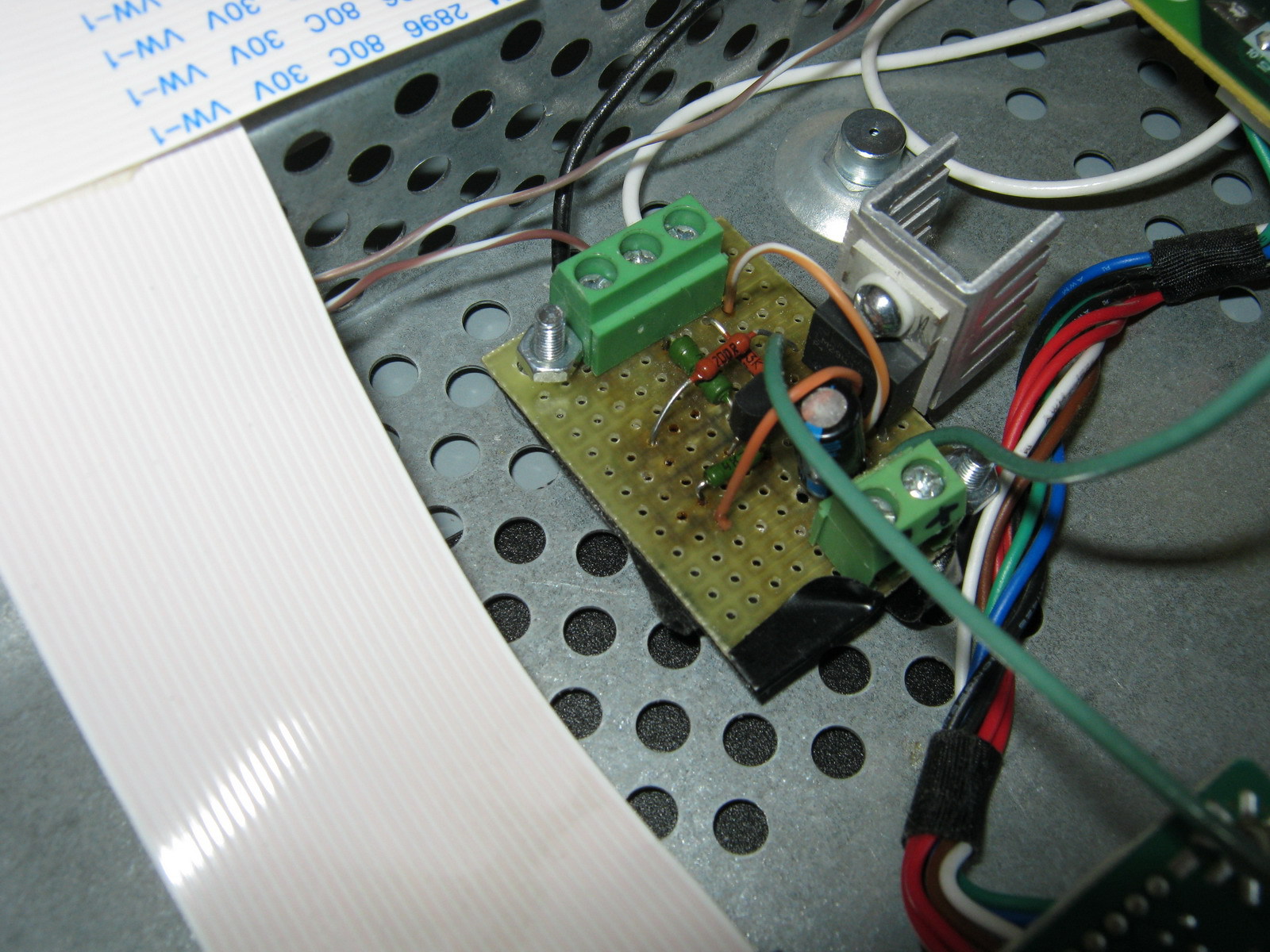
The power and control signal On were started from the power supply board:
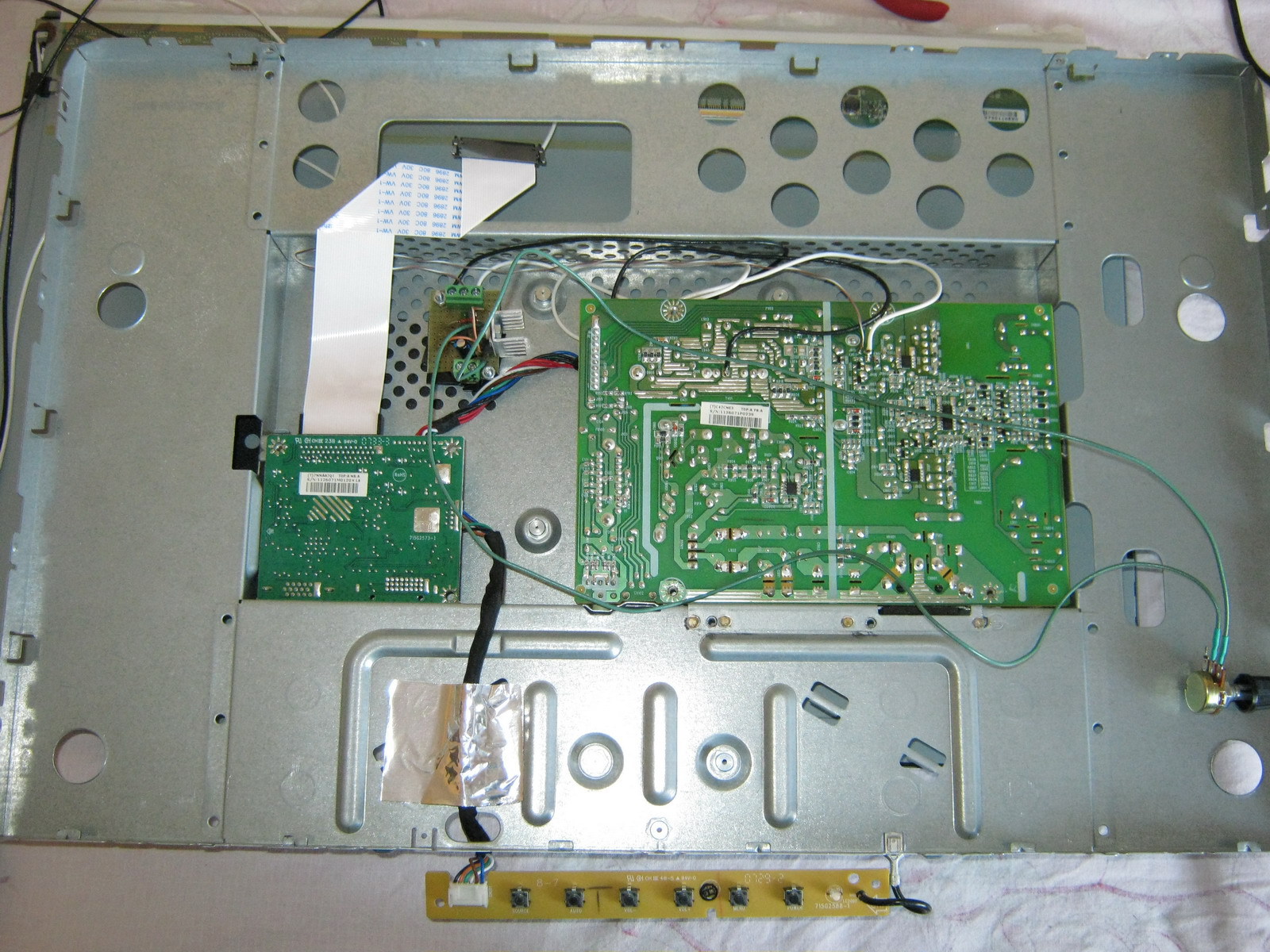
The calculated power allocated to the LM2941 is calculated by the formula:
Pd = (Vin-Vout)*Iout +Vin*IgndFor my case it is Pd = (13.6-13) * 0.7 + 13.6 * 0.006 = 0.5 Watt therefore it was decided to get by with the smallest radiator for LM2941 (planted through a dielectric gasket as it is not insulated from the earth in LM2941).
The final assembly showed itself to be fully functional:

Of the advantages:
- Uses a standard LED strip
- Simple control board
Of the disadvantages:
- Insufficient backlight in bright daylight (the monitor is in front of the window)
- The LEDs in the tape are not located often enough, therefore, small light cones from each individual LED are visible near the upper and lower edges of the monitor
- White balance is a little disturbed and goes slightly into greenish tones (most likely solved by adjusting the white balance of either the monitor itself or the video card)
It is a good, simple and budget option to repair the backlight. It is quite comfortable to watch movies or use the monitor as a kitchen TV, but probably will not work for everyday work.
PWM brightness adjustment
For those habrozhiteli who, unlike me, do not remember with nostalgia the analog control knobs of brightness and contrast on old CRT monitors, you can make control from a regular PWM generated by the monitor control board without putting any additional controls out (without drilling the monitor body). To do this, it is enough to assemble an AND-NOT circuit on two transistors at the On / Off input of the regulator and remove the brightness control at the output (set the output voltage constant to 12-13V). Modified circuit: The
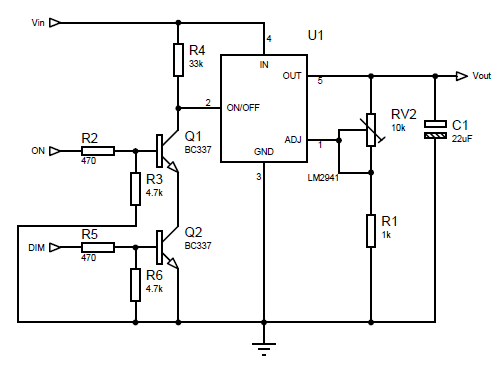
resistance of the tuning resistor RV2 for voltage 13V should be in the region of 9.9kOhm (but it is better to set exactly when the regulator is on)
More dense LED backlight
To solve the problem of insufficient brightness (and at the same time evenness) of the backlight, it was decided to put more LEDs and more often. Since it turned out that buying LEDs is piecewise more expensive than buying 1.5 meters of tape and removing them from there, a more economical option was chosen (to remove the LEDs from the tape).
The 3528 LEDs themselves are located on 4 strips of 6 mm wide and 238 mm in length, 3 LEDs in series in 15 parallel assemblies on each of the 4 strips (wiring boards for LEDs are attached). After soldering the LEDs and wires, the following is obtained: The
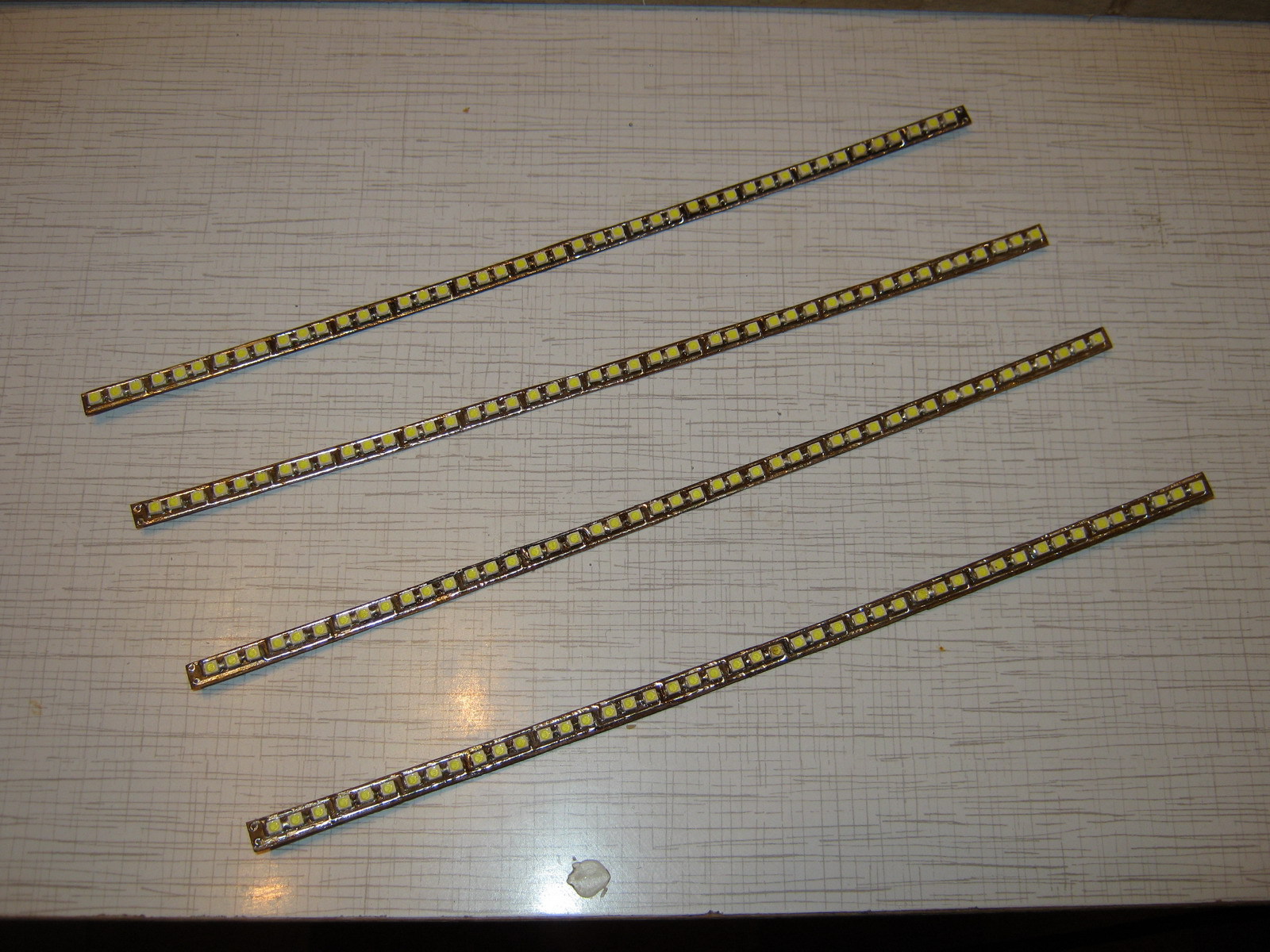

strips are laid in two at the top and bottom with wires to the edge of the monitor in a joint in the center:


The nominal voltage on the LEDs is 3.5V (range from 3.2 to 3.8V), so that an assembly of 3 consecutive LEDs should be powered by a voltage of about 10.5V. So the regulator parameters need to be recalculated: The

maximum voltage we need for the tape is 10.5V. Those. the maximum value of R2 = 1000 * (10.5 / 1.275-1) = 7.23kOhm. The minimum voltage at which the LED assembly is still somehow lit is about 4.5 volts, i.e. minimum value R2 = 1000 * (4.5 / 1.275-1) = 2.53kOhm. R2 we have consists of a variable resistor RV1 and a multi-turn trimming resistor RV2. The resistance of RV1 is 7.23kOhm - 2.53kOhm = 4.7kOhm, and we set RV2 to about 7.23-4.7 = 2.53kOhm and are adjusted in the assembled circuit to get 10.5V at the output of LM2941 with a maximum resistance of RV1.
One and a half times more LEDs consume 1.2A of current (nominally), therefore the dissipated power on LM2941 will be equal to Pd = (13.6-10.5) * 1.2 + 13.6 * 0.006 = 3.8 Watts, which already requires a more solid radiator for heat dissipation:
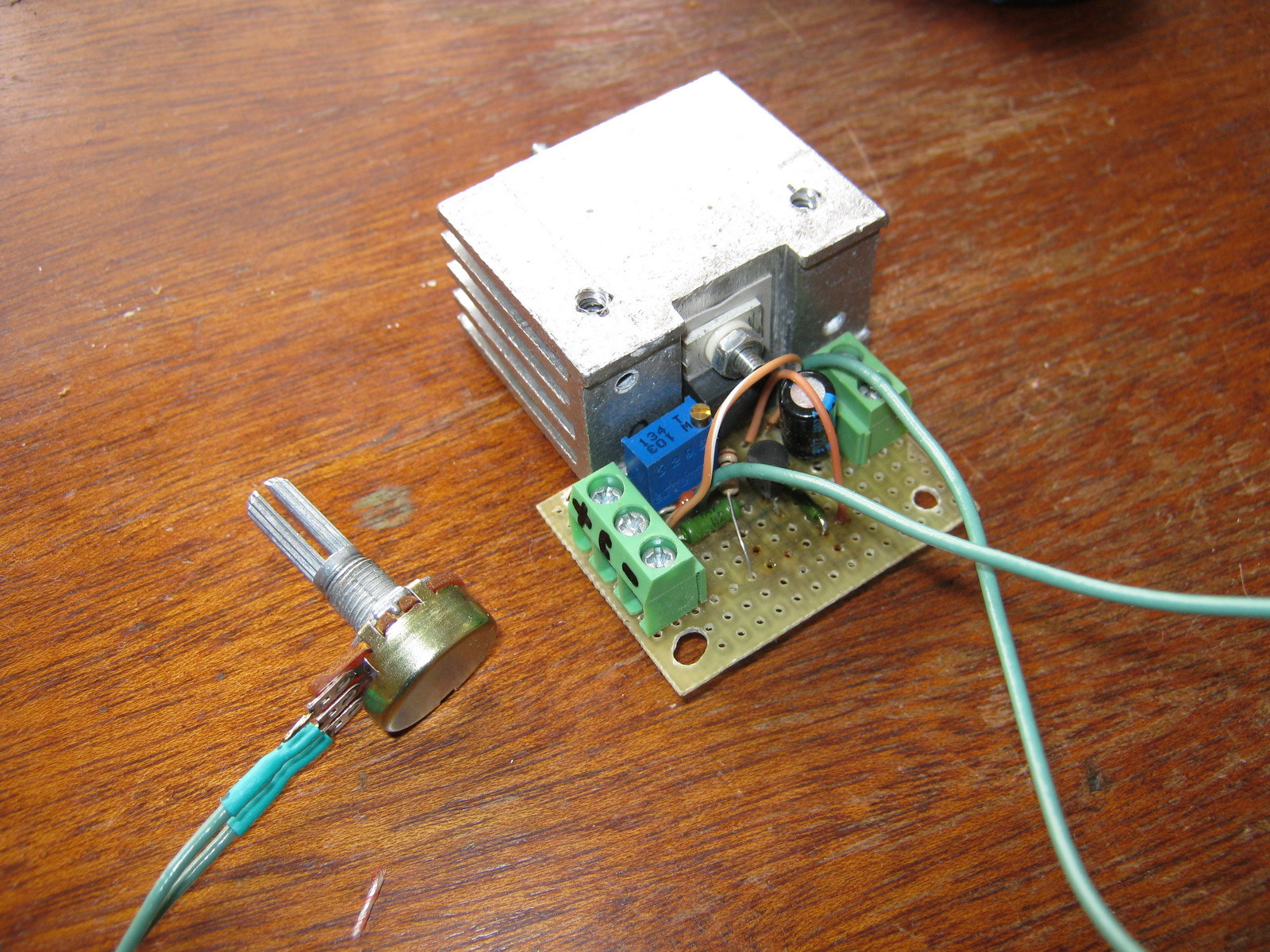
We assemble, connect , we get much better:

Advantages:
- A sufficiently large brightness (possibly comparable, and perhaps even superior to the brightness of the old CCTL backlight)
- The absence of light cones along the edges of the monitor from individual LEDs (LEDs are located quite often and the backlight is uniform)
- Still simple and cheap control board
Disadvantages:
- The issue of white balance, leaving in greenish tones, wasn’t solved at all.
- LM2941, although with a large radiator, but heats up and warms everything inside the case
Step-down controller based control board
To eliminate the heating problem, it was decided to assemble a brightness regulator based on a Step-down voltage regulator (in my case, LM2576 was selected with a current of up to 3A). It also has an inverted On / Off control input, so for matching there is the same inverter on one transistor:

Coil L1 affects the efficiency of the converter and should be 100-220 μG for a current in the load of about 1.2-3A. The output voltage is calculated by the formula:
Vout=Vref*(1+R2/R1)where Vref = 1.23V. For a given R1, you can get R2 by the formula:
R2=R1*(Vout/Vref-1)In the calculations, R1 is equivalent to R4 in the circuit, and R2 is equivalent to RV1 + RV2 in the circuit. In our case, to adjust the voltage in the range from 7.25V to 10.5V, we take R4 = 1.8kOhm, a variable resistor RV1 = 4.7kOhm and a tuning resistor RV2 at 10kOhm with an initial approximation of 8.8kOhm (after assembling the circuit, it is best to set its exact value by measuring voltage at the output of LM2576 with a maximum resistance of RV1).
For this controller decided to make a board (they didn’t matter, because the monitor had enough space for mounting even a dimensional board):
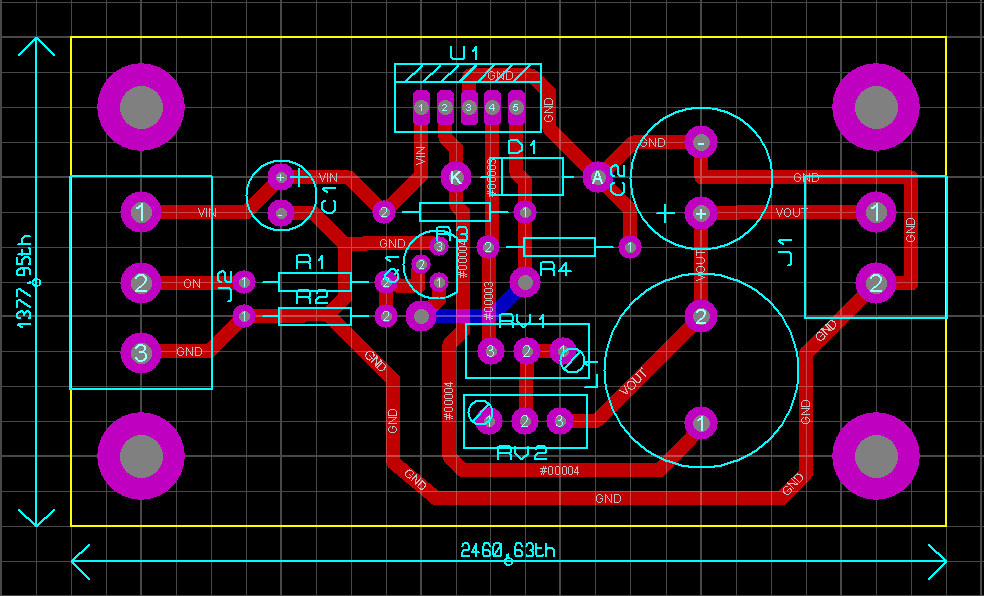
Control board assembly:
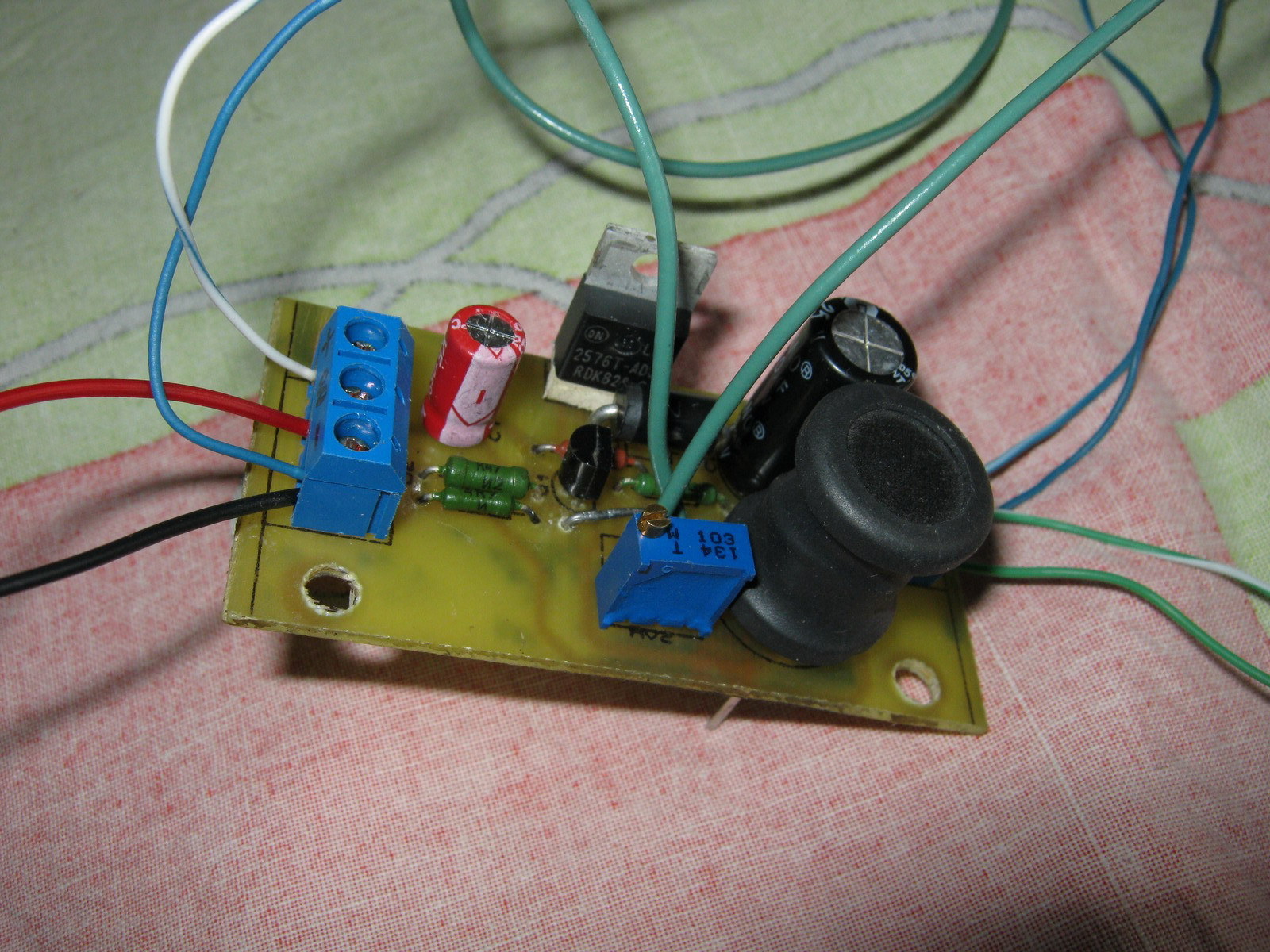
After mounting in the monitor:
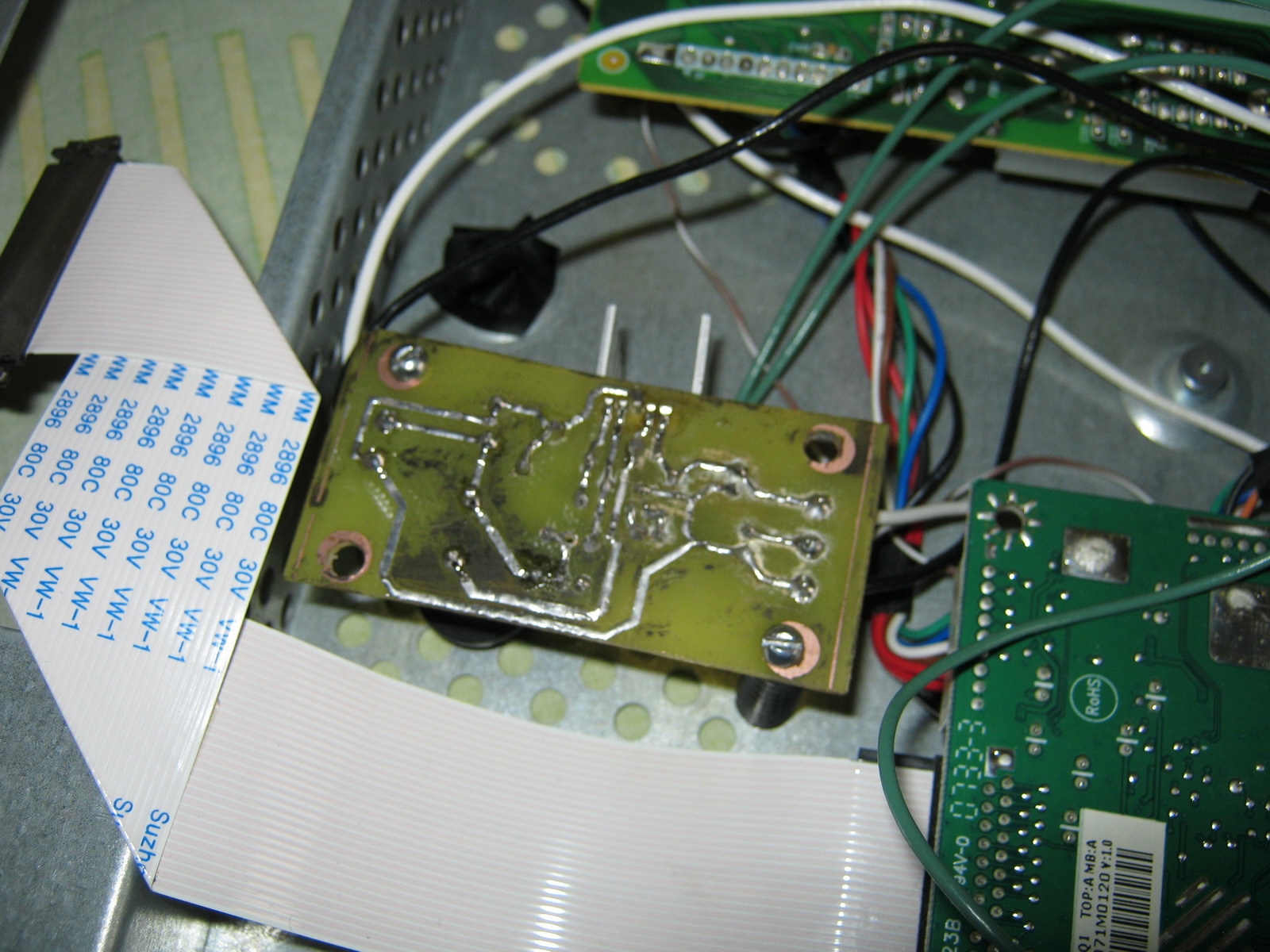
Everything assembled:

After assembly everything seems to work:

The final version:
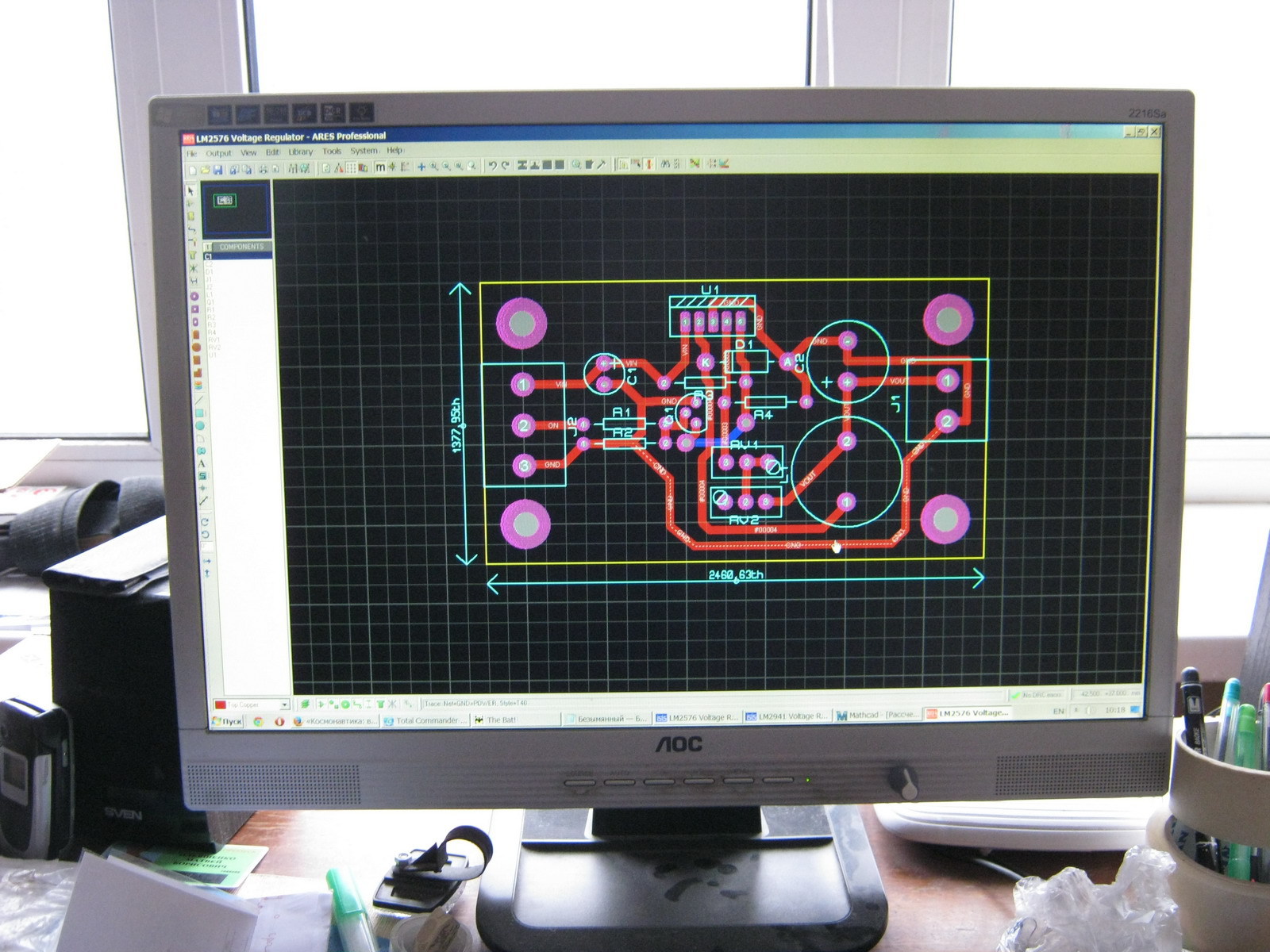
Advantages:
- Sufficient brightness
- Step-down regulator does not heat up and does not warm the monitor
- No PWM, which means nothing blinks at any frequency
- Analog (manual) brightness control
- There are no restrictions on the minimum brightness (for those who like to work at night)
Disadvantages:
- White balance is slightly shifted towards green tones (but not much)
- At low brightness (very low), unevenness in the glow of the LEDs of different assemblies is visible due to the variation in parameters
Improvement Options:
- White balance is adjustable both in the monitor settings and in the settings of almost any video card
- You can try to put other LEDs that will not noticeably reduce white balance
- To eliminate the uneven illumination of LEDs at low brightness, you can use: a) PWM (adjust the brightness using PWM always supplying the rated voltage) or b) connect all the LEDs in series and power them with an adjustable current source (if all 180 LEDs are connected in series, then 630V and 20mA), then the same current should pass through all the LEDs, and each one will have its own voltage drop, the brightness is regulated by changing the current and not the voltage.
- If you want to make a PWM-based circuit for LM2576, you can use the NAND circuit on the On / Off input of this Step-down regulator (similar to the circuit shown for LM2941), but it is better to put a dimmer in the gap of the negative LED wire through the logic-level mosfet
According to the link , you can download:
- AOC2216Sa Service Manual
- LM2941 and LM2576 datasheets
- Controller circuits on LM2941 in Proteus 7 and PDF format
- PCB layout for LEDs in Sprint Layout 5.0 format
- Schematic and wiring of the controller board on the LM2576 in Proteus 7 and PDF format
